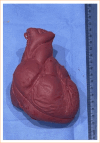Pericardiocentesis simulation model: conception and development
- PMID: 40699128
- PMCID: PMC12273871
- DOI: 10.1590/acb404725
Pericardiocentesis simulation model: conception and development
Abstract
Purpose: To develop a pericardiocentesis (PCT) simulation model applied for undergraduate medical training.
Methods: A PCT simulator consisted of a torso mannequin, a silicone rubber heart (SRH), a container, and a filling system. The mannequin was submitted to a coronal section and an 18 × 18-cm precordial area opening. The SRH was prepared in accordance with structural dimensions of a normal heart. The elaboration of a structure container to simulate the pericardial cavity consisted of a non-leakable unit inside a cardboard (PcavBox). The PcavBox filling system was connected to a 10-mm diameter tube and a total of 2.5 L of saline solution. This structure was adapted inside the mannequin and covered with a thermoformable rubber material of 2 mm in skin color. For PCT simulation, we used a 10-mL syringe connected to a 14G needle for an imaging guided puncture facilitated by a portable ultrasound.
Results: A SRH was successfully developed and fixed inside the Pcav Box, connected to the fluid pressure system. It was able to simulate a cardiac tamponade scenario identified by ultrasound. A series of 50 punctures was successively performed without liquid leak.
Conclusion: A low-cost PCT simulator was developed and coan be applied to healthcare education.
Conflict of interest statement
Figures






References
-
- Flato UAP, Guimaraes HP. Simulation-based education in urgent and emergency medicine: art imitates life. Rev Bras Clin Med. 2011;9(5):5–9.
-
- Adler Y, Charron P, Imazio M, Badano L, Barón- Esquivias G, Bogaert J, Brucato A, Gueret P, Klingel K, Lionis C, Bernhard M, Bongani M, Alain P, Arsen DR, Manel ST, Petar S, Karl S, Witold T, ESC Scientific document Group 2015 ESC Guidelines for the diagnosis and management of pericardial diseases: the task force for the diagnosis and management of pericardial diseases of the European Society of Cardiology (ESC) Endorsed by: The European Association for Cardio-Thoracic Surgery (EACTS) Eur Heart J. 2015;36(42):2921–2964. doi: 10.1093/eurheartj/ehv318. - DOI - PMC - PubMed
MeSH terms
LinkOut - more resources
Full Text Sources

